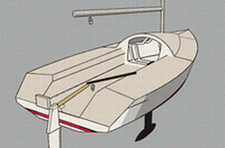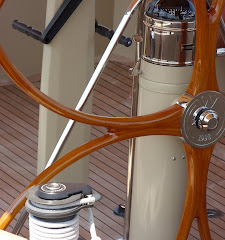The plans call for the keel to be wrapped with 1 continued layer of 12 oz biaxial fabric clamping at the trailing edge. You do this 5 times to complet the layup. I found this method to be very annoying, trying to keep one side tight while working on the other. What I ended up doing was to wrap one edge around the trailing edge and to the line of the 5 layers of tape applied earlier. This allows the fabric to be kept taught and does not effect the foil shape as the entire keel will be faired before painting. The other side is brought back to the trailing edge and left wet to hang by it’s own weight and will be trimmed once the epoxy begins to harden enough to prevent moving the fabric (about 1 ½ hours with the Marinepoxy medium hardener). The scantlings call for the trailing edge to be ground to a 30 degree angle as the final shaping/fairing is done so again the clamping at the trailing edge does not make a difference.
On my previous post there was no update for the time spent on the project. To get us back up to speed here are the new totals. This is as of today’s work including the last post.
Time: Glue up stock ½ hour
Square and plane stock to size 1 hour
Layout lines and cut kerfs ½ hour
Rough plane to shape 1 hour
Sand to final shape before fiberglass strips are added 1 hour
Lay in 5 layers biaxial tape as called (each side) ½ hour
Fairing – 2 layers (each side) ½ hour (does not include time for epoxy to dry before sanding)
Lay biaxial fabric 1 hour
Total this segment 7 hours Total Project 91 ½ hours
Saturday, September 6, 2008
Tuesday, September 2, 2008
What happens in August, Stays in August
I can’t believe I skipped the entire month of August without a single post. A few reasons including a slump in boatbuilding enthusiasm I suppose. If you follow the forum thread you know I did get some work done on the keel. This step is not nearly as intimidating as it looks and if I had been a little more driven it could be done in about 2-3 days including time for epoxy to dry.
The process is to make a blank from Douglas fir large enough to carve the keel out of. In my case there is no 2” x 4” Douglas fir available in the area so 1” x 4” material would have to suffice. I will say though if I had to do this over I would either search a little further for the 2” x 4” or use another species and consider even larger dimensions. The blank needs to be approximately 14” x 1 ½” by 6’. I made this up a little oversize to allowing the whole thing to be planed and squared after gluing up.

Somewhere years ago I had made up some parts with a similar shape and used the same technique to do the keel. What you do is layout a set of equidistant lines in this case ¾” length wise on the stock. Then measuring from the horizontal surface of the part you can cut a kerf into the blank corresponding to the depth you need to remove at each mark. The kerfs now serve as your depth gauge and you simply trim away the unwanted area with a plane. If you spray-paint the whole thing after you cut the kerfs you will be able to readily see your gauges.

Follow this up with the belt sander and orbital sander and in no time you have the shape complete.
The scantlings call for 5 layers of reinforcing along the length with biaxial fabric or tape in widths ranging from about 5” down to 1 ½”. This also adds dimension to the keel and helps form the final shape. After applying the fabric I faired the entire keel with a mix of epoxy and wood flour. I cut out a template from some scrape masonite and used this as a trowel to get the shape fair and even the length of the keel.

The final step is to wrap the entire keel in a continuous layer of biaxial fabric, fair and paint.
Now keep in mind that this must be done in order to build the keel box otherwise you would just be guessing at the finished size of the keel and a tight fit is important here. The 350 lb bulb that goes on the end will be cast at a latter time as it has no bearing on the building process now.
Getting back to work on this has certainly put us back in the building mode and although off schedule by a few weeks we should get the boat finished up quickly now. The next steps are simple ones such as putting the keel box in place; setting the floor then the deck and that makes a boat.
The process is to make a blank from Douglas fir large enough to carve the keel out of. In my case there is no 2” x 4” Douglas fir available in the area so 1” x 4” material would have to suffice. I will say though if I had to do this over I would either search a little further for the 2” x 4” or use another species and consider even larger dimensions. The blank needs to be approximately 14” x 1 ½” by 6’. I made this up a little oversize to allowing the whole thing to be planed and squared after gluing up.

Somewhere years ago I had made up some parts with a similar shape and used the same technique to do the keel. What you do is layout a set of equidistant lines in this case ¾” length wise on the stock. Then measuring from the horizontal surface of the part you can cut a kerf into the blank corresponding to the depth you need to remove at each mark. The kerfs now serve as your depth gauge and you simply trim away the unwanted area with a plane. If you spray-paint the whole thing after you cut the kerfs you will be able to readily see your gauges.

Follow this up with the belt sander and orbital sander and in no time you have the shape complete.
The scantlings call for 5 layers of reinforcing along the length with biaxial fabric or tape in widths ranging from about 5” down to 1 ½”. This also adds dimension to the keel and helps form the final shape. After applying the fabric I faired the entire keel with a mix of epoxy and wood flour. I cut out a template from some scrape masonite and used this as a trowel to get the shape fair and even the length of the keel.

The final step is to wrap the entire keel in a continuous layer of biaxial fabric, fair and paint.
Now keep in mind that this must be done in order to build the keel box otherwise you would just be guessing at the finished size of the keel and a tight fit is important here. The 350 lb bulb that goes on the end will be cast at a latter time as it has no bearing on the building process now.
Getting back to work on this has certainly put us back in the building mode and although off schedule by a few weeks we should get the boat finished up quickly now. The next steps are simple ones such as putting the keel box in place; setting the floor then the deck and that makes a boat.
Subscribe to:
Posts (Atom)






